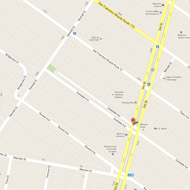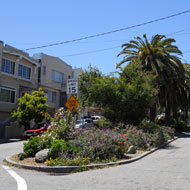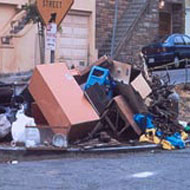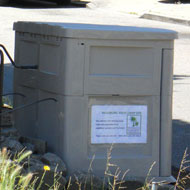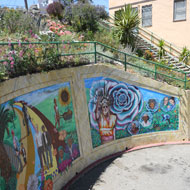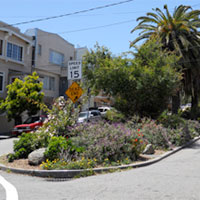
San Francisco, California
Background
The community garden on Quesada Avenue extends from Third Street on the east to Newhall Street on the west. It is located in the Bayview-Hunters Point neighborhood, a disadvantaged neighborhood in the southeastern part of San Francisco. The food is primarily grown on the median strip in Quesada Avenue, which is approximately 600 feet long and 20 feet wide. There is one 20-foot wide two-way road, including one parking lane, on the south side of the median and one 20-foot wide cul-de-sac on the north side. The cul-de-sac and the median were constructed to address changes in elevation. The block is constructed against a hill. The two lanes of Quesada Avenue followed the contours of the land, leaving the median in the middle.
The designated traffic speed on Quesada Ave is 15 mph. The traffic is slower in the cul-de-sac section of the road and a little higher on the through section of the street. The average daily traffic volume on Quesada Avenue at 3rd Street is about 667 vehicles westbound and 662 vehicles eastbound per day (San Francisco Metropolitan Transportation Agency 2010).
The Quesada neighborhood was an unsafe place to live because of drug dealers and crime. There were many vacant houses and abandoned vehicles on the strip. Bayview-Hunter’s Point was deficient in environmental health assets, such as full-service grocery stores and safe public parks (San Francisco Department of Public Health 2006). In 2002 when Karl Paige and Annette Young Smith started the garden on the street median, the neighborhood began to change to a safer, healthier place. The street median had been a dumping ground for car parts, mattresses and other jetsam. This inspired the residents to form the Quesada Gardens Initiative, a grassroots, community-building movement that illustrates the possibilities of transforming a blighted neighborhood into a healthy community (Quesada Gardens).
Quesada Gardens Initiative
Community engagement is key to the success of the project. The Quesada Gardens Initiative (QGI), with about 30 residents considered as co-founders, shows the trend toward local, comprehensive approaches to sustainable social and environmental movements. QGI is a local change strategy created and led by the local residents. Karl Paige, one of the co-founding gardeners, passed away in 2007, but this grassroots movement did not stop. Annette Young Smith remains the Chair of QGI’s Board of Directors. Neighbors have developed various projects, including the Founders’ Memorial Vista, food and floral gardens, public art projects and events that increase community participation. Under QGI, residents have created nine community gathering spaces, 12 backyard gardens, two major murals and a stream of popular events. While the most efficacious food production happens in the over 20 large backyard gardens and the community projects devoted to food production, such as the Bridgeview Teaching and Learning Garden, QGI has generated social cohesion through the development of the median strip on Quesada Avenue. This has resulted in a symbol that resonates with those interested in urban agriculture, and a physical hub that supports food production throughout the QGI network of projects (Betcher 2011).
QGI settled on resident-led design and implementation principles, as well as consensus-based decision-making processes to create the Quesada Gardens. The community-builders associated with the Quesada Gardens Initiative have been engaged in designing gardens, gathering spaces and public art in the neighborhood. In particular, Seth Wachtel, a professor at the University of San Francisco, and his students contributed to the design and building of the garden. They have attended community gatherings, recorded the consensus of the groups and created drawings. In the Quesada median strip there are variety of edible, ornamental and medicinal plants and flowers, such as collard, mustard and turnip greens, lettuce, cabbage, corn, peanuts, blue dahlia, lavender, aloe vera, sage, geraniums, calla lilies and cacti (Moody 2006). There are facilities like a composter on the strip, as well as a weekly volunteer program to support the urban agriculture. It is also a hub of a shared food program in the neighborhood, which was requested by Quesada residents. Food distribution is centered on families, churches and long-standing affinity group social networks (Betcher 2011).
Lessons Learned
Potential Benefits:
- Reduces health disparities by effectively encouraging better nutrition and physical activity.
- Prevents violence by strengthening social cohesion across demographic lines and by developing respect among diverse residents.
- Builds community by consistently involving new and long-term residents, and encouraging their reinvestment.
- Slows traffic through the lush mix of plants and trees planted in the median (QuesadaGardensblog).
- Reuses underutilized public land and demonstrates the potential for better utilizing other strips and small or irregular plots of land in the city.
- Beautifies an unsightly median, transforming it into an attractive edible landscape that is the pride and joy of residents. It stops littering and dumping when other strategies have failed.
- Improves the environment by reducing carbon emissions associated with transporting food. Visually, murals on adjoining walls not only celebrate the history of community garden, but provide the neighborhood with a unique sense of identity.
- Catalyzes other community garden projects throughout the neighborhood.
Potential Issues:
- Infrastructure: Some skill and expertise is needed to design and build the garden infrastructure.
- Funding: Grant-writing and fundraising skills are needed to support the project.
- Volunteer leadership: Strong project leadership is needed and volunteer burnout can create difficulties.
- Crime and loitering: The installation of fake cameras has discouraged loitering and crime in the Quesada Gardens (Quesada Gardens Initiative Board Meeting).
Sources
San Francisco Department of Public Health, 2006. “Health Programs in Bayview Hunter’s Point & Recommendations for Improving the Health of Bayview Hunter’s Point Residents”(http://www.sfdph.org/dph/files/reports/StudiesData/HlthProgsBVHPyRecommends07052006B.pdf)
Interview with Jeffrey Betcher, Quesada Gardens Initiative on June 30, 2011
Patricia Yollin, 2006, “4 Years After a Scrubby Median Patch was Planted, Crime is Down and Neighbors Cultivate Friendship as Well as Flowers” (http://articles.sfgate.com/2006-07-18/bay-area/17303578_1_community-garden-landmark-status-concrete-jungle)
QuesadaGardensBlog, “New Bayview Gardens!” (http://quesadagardensblog.blogspot.com/2010/09/new-bayview-gardens.html)
QuesadaGardensBlog. “Quesada Garden Gets Serious About Food Production.” (http://quesadagardensblog.blogspot.com/2008/04/quesada-garden-gets-serious-about-food.html)
Quesada Gardens Initiative Board Meeting. April 13, 2009
Quesada Gardens Initiative. “History” (http://www.quesadagardens.org/history.php)
San Francisco Metropolitan Transportation Agency, July 2010. “ADT Counts.” (http://www.sfmta.com/cms/vhome/documents/ADTCountsJuly2010.pdf)
Shelah Moody, 2006. “Jefferson Awards: Karl Paige and Annette Smith: Quesada Avenue Neighbors Transform a Dismal Median Strip into Bright Oasis” (http://articles.sfgate.com/2006-03-19/living/17287485_1_plants-neighbor-and-community-activist-annette-smith)
Photo Sources
MIG, Inc.

